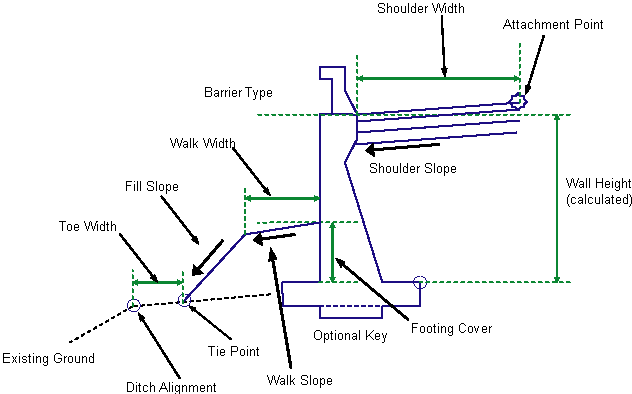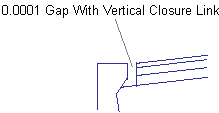This subassembly inserts a retaining wall structure with a paved shoulder and with special tie slopes to tie to an existing ditch.

This subassembly can place an optional barrier on the top of the wall and an optional key below the footing.
Attachment
The attachment point is on the inside of the shoulder.
Input Parameters
Note: All dimensions are in meters or feet unless otherwise noted. All slopes are in run-over-rise form (for example, 4 : 1), unless indicated as a percent slope with a “%” sign.
| Parameter | Description | Type | Default |
|---|---|---|---|
| Side |
Specifes to insert the subassembly either on the right or the left side of the attachment point. |
Left / Right | Right |
| Shoulder Width | Width of the shoulder from the attachment point | Numeric, Positive |
4.0 ft 1.33 m |
| Pave 1 Depth | Depth of Pave 1, Enter ZERO if no Pave 1 | Numeric, Positive |
0.083 ft 0.025 m |
| Pave 2 Depth | Depth of Pave 2, Enter ZERO if no Pave 2 | Numeric, Positive |
0.083 ft 0.025 m |
| Base Depth | Depth of base layer |
Numeric, positive |
0.333 ft 0.1 m |
|
Subbase Depth |
Depth of the subbase layer. |
Numeric, positive |
0.3 m 1.0 ft |
| Wall Width | Specifies the width of the wall. | Numeric |
0.958 ft 0.292 m |
| Footing Cover | The depth of cover from the top-of-footing to the finish grade line on the back side of the wall in fill or to the hook when in cut. | Numeric |
1.667 ft 0.50 m |
| Key | Species to add an optional key below the footing | Boolean | Yes |
| Use Barrier | Specifies to use a barrier on the top of the wall | String, (a) Yes, (b) No | Yes |
| Use Superelevation Slope |
Specifies to use superelevation slope |
Selection list | No |
| Slope Direction |
Specifies whether the shoulder slopes away from the crown or towards the crown |
Selection list | Away from Crown |
| Default Shoulder Slope | Default cross slope of the shape surface. The value is used if the superelevation slope is not used or is not specified for the baseline alignment. | Numeric, Positive | - 2.0% |
| Walk Width | Width of the walkway link on the tie slope | Numeric, Positive |
3.300 ft 1.0 m |
| Walk Slope | Slope of the walkway link (grade/slope type) | Numeric | 25 % |
| Fill Slope | Slope of the fill link from the walkway to the tie point (Slope type) | Numeric | 2.00 : 1 |
| Toe Width | Width from ditch point to the tie point (to existing inside edge of the ditch) | Numeric, Positive |
1.670 ft 0.5 m |
Wall height is determined from top of the footing to attachment point of ground elevation on the vertical face, whichever is higher. Wall battered slope, width of the footing, offset of wall vertical face, optional key dimensions, and the location of the key center are all functions of the wall height.
Target Parameters
This section lists the parameters in this subassembly that can be mapped to one or more target objects, such as a surface, alignment, or profile object in a drawing. For more information, see To Specify Corridor Targets.
| Parameter | Description | Status |
|---|---|---|
| Edge of Shoulder | May be used to override the shoulder slope by tieing to a profile. The following object types can be used as targets for specifying this elevation: profiles, 3D polylines, feature lines, or survey figures. | Optional |
| Ditch Offset | Inside edge of ditch profile used to locate Tie Point. The following object types can be used as targets for specifying this offset: alignments, polylines, features lines, or survey figures. | Required |
| Tie-in Surface | Existing ground surface to tie in with respect to specified ditch and toe width. The following object types can be used as targets for specifying this surfaces: surfaces. | Required |
Output Parameters
None.
Behavior
This subassembly can be inserted either on the left or the right sides. The attachment point is assumed to be at the design edge-of-traveled-way, from where the paved shoulders will be drawn as specified by this subassembly.
The top-of-footing elevation is determined by working inwards from the Tie Point to the inside edge of walkway, then subtracting the Footing Cover from the tie link at the offset of the outside footing corner. The height of wall (H) is calculated between the Outside Edge of the Shoulder and the top of footing. If the Key option is set to No, then the base of the footing is a single horizontal link. If the Key option is used, links to define the optional key are inserted.
Note: A very small gap (0.001 for m) is left between the pavement layers and the inside face of wall. This is to facilitate material analysis using the quantity takeoff feature, as shown in the detail below.

Layout Mode Operation
In layout mode, the subassembly draws the retaining wall shape as specified by the input parameter values, assuming that the subassembly is in a fill condition.
Point, Link, and Shape Codes
The following table lists the point, link, and shape codes for this subassembly that have codes assigned to them. Point, link, or shape codes for this subassembly that do not have codes assigned are not included in this table.
| Point/Link | Codes | Description |
|---|---|---|
| P2 | Daylight | |
| P3 | Walk_Edge | Edge of the walk width |
| P14 | RW_Hinge | |
| P12 | RW_Inside | Could be used as breaklines in building datum surface |
| P5 | RW_Outside | Could be used as breaklines in building datum surface |
| L1, L2, L3 | Top | |
| L2, L3 | Wall | |
| L4,L5,L6 | Footing | Bottom of the footing |
| L7 | Pave1 | |
| L8 | Pave2 | |
| L9 | Base, Footing_Bottom | |
| S1 | RWall | |
| S2 | Barrier | |
| S3 | Pave1 | |
| S4 | Pave2 | |
| S5 | Base |
Coding Diagram
